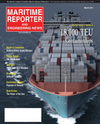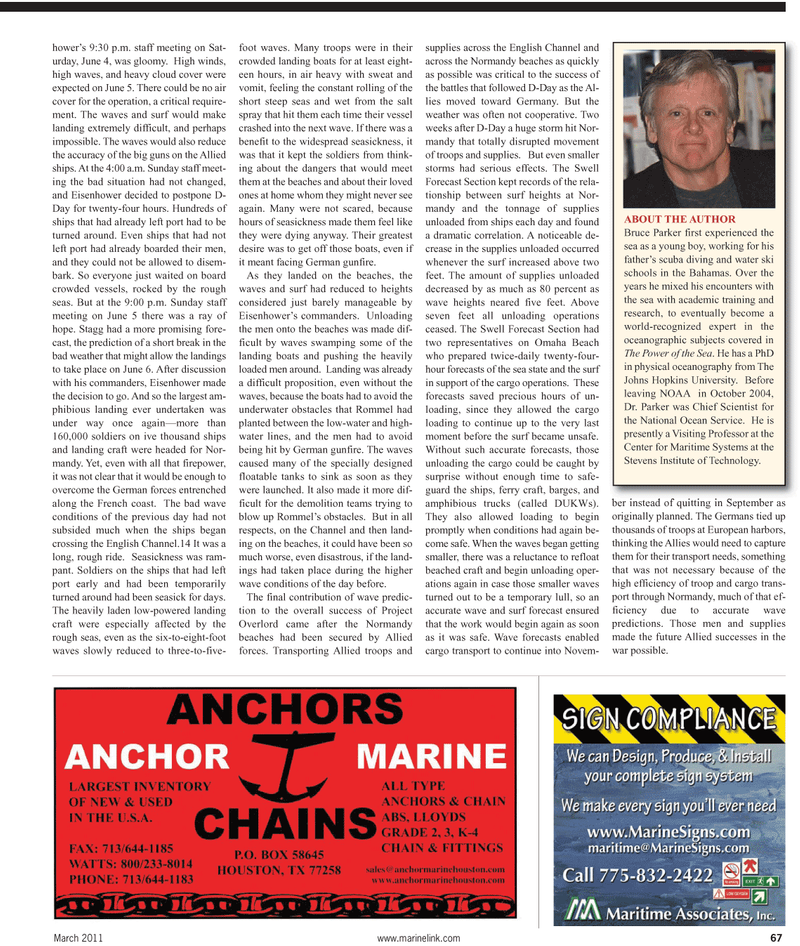
Page 67: of Maritime Reporter Magazine (March 2011)
Ship Repair & Conversion
Read this page in Pdf, Flash or Html5 edition of March 2011 Maritime Reporter Magazine
March 2011 www.marinelink.com 67 hower’s 9:30 p.m. staff meeting on Sat- urday, June 4, was gloomy. High winds, high waves, and heavy cloud cover were expected on June 5. There could be no air cover for the operation, a critical require- ment. The waves and surf would make landing extremely difficult, and perhaps impossible. The waves would also reduce the accuracy of the big guns on the Allied ships. At the 4:00 a.m. Sunday staff meet- ing the bad situation had not changed, and Eisenhower decided to postpone D-
Day for twenty-four hours. Hundreds of ships that had already left port had to be turned around. Even ships that had not left port had already boarded their men, and they could not be allowed to disem- bark. So everyone just waited on board crowded vessels, rocked by the rough seas. But at the 9:00 p.m. Sunday staff meeting on June 5 there was a ray of hope. Stagg had a more promising fore- cast, the prediction of a short break in the bad weather that might allow the landings to take place on June 6. After discussion with his commanders, Eisenhower made the decision to go. And so the largest am- phibious landing ever undertaken was under way once again—more than 160,000 soldiers on ive thousand ships and landing craft were headed for Nor- mandy. Yet, even with all that firepower, it was not clear that it would be enough to overcome the German forces entrenched along the French coast. The bad wave conditions of the previous day had not subsided much when the ships began crossing the English Channel.14 It was a long, rough ride. Seasickness was ram- pant. Soldiers on the ships that had left port early and had been temporarily turned around had been seasick for days.
The heavily laden low-powered landing craft were especially affected by the rough seas, even as the six-to-eight-foot waves slowly reduced to three-to-five- foot waves. Many troops were in their crowded landing boats for at least eight- een hours, in air heavy with sweat and vomit, feeling the constant rolling of the short steep seas and wet from the salt spray that hit them each time their vessel crashed into the next wave. If there was a benefit to the widespread seasickness, it was that it kept the soldiers from think- ing about the dangers that would meet them at the beaches and about their loved ones at home whom they might never see again. Many were not scared, because hours of seasickness made them feel like they were dying anyway. Their greatest desire was to get off those boats, even if it meant facing German gunfire.
As they landed on the beaches, the waves and surf had reduced to heights considered just barely manageable by
Eisenhower’s commanders. Unloading the men onto the beaches was made dif- ficult by waves swamping some of the landing boats and pushing the heavily loaded men around. Landing was already a difficult proposition, even without the waves, because the boats had to avoid the underwater obstacles that Rommel had planted between the low-water and high- water lines, and the men had to avoid being hit by German gunfire. The waves caused many of the specially designed floatable tanks to sink as soon as they were launched. It also made it more dif- ficult for the demolition teams trying to blow up Rommel’s obstacles. But in all respects, on the Channel and then land- ing on the beaches, it could have been so much worse, even disastrous, if the land- ings had taken place during the higher wave conditions of the day before.
The final contribution of wave predic- tion to the overall success of Project
Overlord came after the Normandy beaches had been secured by Allied forces. Transporting Allied troops and supplies across the English Channel and across the Normandy beaches as quickly as possible was critical to the success of the battles that followed D-Day as the Al- lies moved toward Germany. But the weather was often not cooperative. Two weeks after D-Day a huge storm hit Nor- mandy that totally disrupted movement of troops and supplies. But even smaller storms had serious effects. The Swell
Forecast Section kept records of the rela- tionship between surf heights at Nor- mandy and the tonnage of supplies unloaded from ships each day and found a dramatic correlation. A noticeable de- crease in the supplies unloaded occurred whenever the surf increased above two feet. The amount of supplies unloaded decreased by as much as 80 percent as wave heights neared five feet. Above seven feet all unloading operations ceased. The Swell Forecast Section had two representatives on Omaha Beach who prepared twice-daily twenty-four- hour forecasts of the sea state and the surf in support of the cargo operations. These forecasts saved precious hours of un- loading, since they allowed the cargo loading to continue up to the very last moment before the surf became unsafe.
Without such accurate forecasts, those unloading the cargo could be caught by surprise without enough time to safe- guard the ships, ferry craft, barges, and amphibious trucks (called DUKWs).
They also allowed loading to begin promptly when conditions had again be- come safe. When the waves began getting smaller, there was a reluctance to refloat beached craft and begin unloading oper- ations again in case those smaller waves turned out to be a temporary lull, so an accurate wave and surf forecast ensured that the work would begin again as soon as it was safe. Wave forecasts enabled cargo transport to continue into Novem- ber instead of quitting in September as originally planned. The Germans tied up thousands of troops at European harbors, thinking the Allies would need to capture them for their transport needs, something that was not necessary because of the high efficiency of troop and cargo trans- port through Normandy, much of that ef- ficiency due to accurate wave predictions. Those men and supplies made the future Allied successes in the war possible.
ABOUT THE AUTHOR
Bruce Parker first experienced the sea as a young boy, working for his father’s scuba diving and water ski schools in the Bahamas. Over the years he mixed his encounters with the sea with academic training and research, to eventually become a world-recognized expert in the oceanographic subjects covered in
The Power of the Sea. He has a PhD in physical oceanography from The
Johns Hopkins University. Before leaving NOAA in October 2004,
Dr. Parker was Chief Scientist for the National Ocean Service. He is presently a Visiting Professor at the
Center for Maritime Systems at the
Stevens Institute of Technology.

 66
66

 68
68
